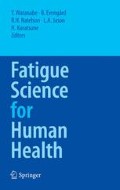Abstract
The mechanisms of the manifestation of central fatigue were studied. In the cerebrospinal fluid (CSF) from exercise-fatigued rats there was a factor that depressed the spontaneous motor activity (SMA) of the animals and caused the kind of behavior that is observed in exhausted animals. A bioassay which utilized hydra, a freshwater coelenterate, strongly suggested the existence of transforming growth factor-β (TGF-β) in the CSF. Because the immunoneutralizing treatment of the CSF from fatigued rats with anti-TGF-β antibody eliminated the factor that depresses the SMA of animals, the identity of this factor was shown to be TGF-β. The findings that the intracisternal administration of purified TGF-β depressed the SMA in a dose-dependent manner, and that the concentration of TGF-β in the CSF increased with an increase in the intensity of the exercise which was being used to cause fatigue, supported the speculation that this factor was responsible for the manifestation of central fatigue. In addition, we also demonstrated that TGF-β acted on the brain and modulated the activities of neurons, and that this changed the whole body metabolism to utilize more fat and enhanced the oxidation of fatty acid.
Access this chapter
Tax calculation will be finalised at checkout
Purchases are for personal use only
Preview
Unable to display preview. Download preview PDF.
References
Newsholme EA, Acworth IN, Blomstrand E (1987) Amino acids, brain neurotransmitters and a functional link between muscle and brain that is important in sustained exercise. In: Benzi G (ed) Advances in myochemistry. John Libbey Eurotext, London, pp 127–133
Blomstrand E, Perrett D, Parry-Billings M, Newsholme EA (1989) Effect of sustained exercise on plasma amino acid concentrations and on 5-hydroxytryptamine metabolism in six different brain regions in the rat. Acta Physiol Scand 136:473–481
Yamamoto T, Newsholme EA (2000) Diminished central fatigue by inhibition of the L-system transporter for the uptake of tryptophan. Brain Res Bull 52:35–38
Lin S, Raabe W (1985) Ammonia intoxication: effects on cerebral cortex and spinal cord. J Neurochem 44:1252–1258
Raabe W, Lin S (1985) Pathophysiology of ammonia intoxication. Exp Neurol 87:519–532
Inoue K, Fushiki T (2003) Exercise and central fatigue. Korean J Exercise Nutr 7:227–233
Inoue K, Yamazaki H, Manabe Y, Fukuda C, Fushiki T (1998) Release of a substance that suppresses spontaneous motor activity in the brain by physical exercise. Physiol Behav 64:185–190
Hanai K, Kato H, Matsuhashi S, Morita H, Raines EW, Ross R (1987) Platelet proteins, including platelet-derived growth factor, specifically depress a subset of the multiple components of the response elicited by glutathione in hydra. J Cell Biol 104:1675–1681
Hanai K, Oomura Y, Kai Y, Nishikawa K, Shimizu N, Morita H, Plata-Salaman CR (1989) Central action of acidic fibroblast growth factor in feeding regulation. Am J Physiol 256: R217–R223
Hanai K (1995) Potentiation of tentacle ball formation by a trypsin-like protease and accompanying augmented ingestion in glutathione-induced feeding in hydra. Zool Sci 12:185–193
Inoue K, Yamazaki H, Manabe Y, Fukuda C, Hanai K, Fushiki T (1999) Transforming growth factor-beta activated during exercise in brain depresses spontaneous motor activity of animals. Relevance to central fatigue. Brain Res 846:145–153
Manabe Y, Yamazaki H, Fukuda C, Inoue K, Fushiki T, Hanai K (2000) Determination of TGF-β-like activity in the rat cerebrospinal fluid after exhaustive exercise using anti-TGF-β IgG and the hydra bioassay. Biomed Res 21:191–196
Manabe Y, Yamazaki H, Fukuda C, Inoue K, Fushiki T, Hanai K (2000) Hydra biological detection of biologically active peptides in rat cerebrospinal fluid. Brain Res Protcol 5:312–317
Manabe Y, Yamazaki H, Fukuda C, Inoue K, Fushiki T, Hanai K (2000) Suppression of S-methylglutathione-induced tentacle ball formation by peptides and nullification of the suppression by TGF-beta in hydra. Chem Senses 25:173–180
Massagué J (1990) The transforming growth factor-β. Annu Rev Cell Biol 6:597–641
Derynck R, Feng X-H (1997) TGF-β receptor signaling. Biochim Biophys Acta 1333: F105–F150
Massagué J, Chen Y-G (2000) Controlling TGF-β signaling. Genes Dev 14:627–644
Arai M, Yamazaki H, Inoue K, Fushiki T (2002) Effects of intracranial injection of transforming growth factor-beta relevant to central fatigue on the waking electroencephalogram of rats. Comparison with effects of exercise. Prog Neuro-Psychopharmacol Biol Psychiatr 26: 307–312
Yamazaki H, Arai M, Matsumura S, Inoue K, Fushiki T (2002) Intracranial administration of transforming growth factor-beta 3 increases fat oxidation in rats. Am J Physiol Endocrinol Metab 283:E536–E544
Bennett AL, Chao CC, Hu S, Buchwald D, Fagioli LR, Schur PH, Peterson PK, Komaroff AL (1997) Elevation of bioactive transforming growth factor-beta in serum from patients with chronic fatigue syndrome. J Clin Immunol 17:160–166
Chao CC, Janoff EN, Hu S, Thomas K, Gallagher M, Tsang M, Peterson PK (1991) Altered cytokine release in peripheral blood mononuclear cell cultures from patients with the chronic fatigue syndrome. Cytokine 3:292–298
Author information
Authors and Affiliations
Editor information
Editors and Affiliations
Rights and permissions
Copyright information
© 2008 Springer
About this chapter
Cite this chapter
Inoue, K., Fushiki, T. (2008). Exercise Fatigue. In: Watanabe, Y., Evengård, B., Natelson, B.H., Jason, L.A., Kuratsune, H. (eds) Fatigue Science for Human Health. Springer, Tokyo. https://doi.org/10.1007/978-4-431-73464-2_14
Download citation
DOI: https://doi.org/10.1007/978-4-431-73464-2_14
Publisher Name: Springer, Tokyo
Print ISBN: 978-4-431-73463-5
Online ISBN: 978-4-431-73464-2
eBook Packages: MedicineMedicine (R0)

